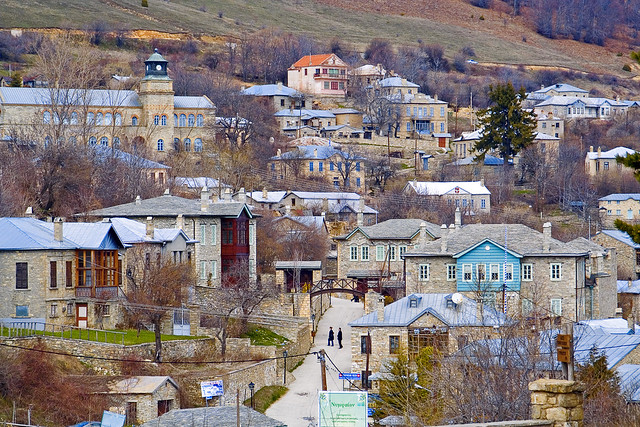.
Administrative Region : West Macedonia
Regional unit : Florina
Nymfaio (Greek: Νυμφαίο, Aromanian: Nevesca) is a predominantly Aromanian village and a former community in Florina regional unit, West Macedonia, Greece. After the 2011 local government reform it became a member of the municipality Amyntaio.[1] Located 16 km south-southeast of Florina, the village had a population of 413 according to the 2001 census, however in 1985, as village records suggest, the population in 1895 was closer to 3,500. Urbanization in Greece left a vacuum, and Nymfai has an estimated fifty permanent residents as of 2008. The village is protected by the Hellenic Ministry of Culture in order to preserve its architectural integrity.

There are currently 6 functioning hotels in Nymfaio as well as a cultural museum and an Orthodox Church. Next to the church is an old cemetery dating to the 18th and 19th centuries.
Nearest places
Aetos, east
Agrapidies, east
Sklithro, south
Asprogeia, SSW
Drossopigi, northwest
Origins of the name
First mentioned in an Ottoman defter in 1481, the village, then known as Neveska, had only six households.[2] The name of the town in Aromanian (Vlach) is Nevesca from the Slavic Nevesta meaning bride.
History
Nymfaio was first settled around 1385 by the Vlach travellers, the latinophony Macedonian inhabitants kept the nearby Via Egnatia for about 1,400 years and later fled from the mountains after the grievous battles with the Ottomans. The warrior settlers of Nymfaio were capitulated later over the mountains. They remained armed and autonomous, directly ruled by Valide Sultan, due to the mother of the Sultan in which paid more reduced times. Until the early 17th century, they lived with ferocious invaders in the cifliks of the field. In 1690*, they began to deliver bronzeware and kicked out from the village to a renowned silvery from all of Macedonia for the next three centuries.
*very likely this date should be 1690, cf. "the next three centuries" (which would bring it to approx. 1990).
During the Albanian invasions in the late 18th century and after the Orlov revolt, Nymfaio accepted Vlach refugees from Moschopoli, Nikolitsa, Linotopi and other Vlach parts which was ruined by the raiders. It was an important populated settlement which moved to eastern Macedonia in the villages including Ano Poroia, Kato Tzoumagia, Alistati, Nigrita, Serres (Serrai) and others. In the Macedonian film of 1878 during the Treaty of San Stefano, the same form of Nymfaio belonged to the gunman Vassilikos Zourkas which headed to the areas of Varnounta and Morihovo[3] and made important benefits, between thest split Mihas Tsirlis.
Modern Nymfaio
A reconstructed traditional mansion.
Nymfai remains in a forested area and features stone sidewalks and stone built houses. The later years with the contributions of famous people which descended from the village, as the president Nikolaos Mertzos and the Boutaris family have become an attraction for local tourism.
The area features an organization known as Arktouros which manages an environmental protection center for brown bears and wolves one and a half kilometre from the village. The center is home to 13 bears along with bear trainers and zoo. The center is also home to several wolves - animals wbich were thought to be too weak to survive in the natural environment. The information centre is open to the public (with a ticket) for several months of the year.
The area has many new visitors, as it was under appreciated in the past. The village is home to the war-torn battlefield of Pavlos Melas, as well as an old school, the Nikeios Skoli. The school was a gift from Nymfaioti Ioanni Jean Nikou (1875–1930). He was a student for many years, and eventually completed his education at the Aristotelian University of Thessaloniki.
Nymfaio is 7–8 km away from the main road, located in the town of Aetos; the road was not paved until the 1950s.
A street in the city of Skopje is named after the village (Neveska) in gratitude to its participation in the Ilinden Uprising.
Notes
^ Kallikratis law Greece Ministry of Interior (Greek)
^ Kravari, Vassiliki (1989) (in French). Villes et villages de Macédoine occidentale. Realites byzantines. 2. Paris: Editions P. Lethielleux. p. 304. ISBN 2-283-60452-4.
^ Νομαρχιακή Αυτοδιοίκηση Κοζάνης, Ελένη Βασιλείου, "Εορδαία - Η συντήρηση της πολιτιστικής μας κληρονομιάς είναι πολιτιστική παραγωγή" (Kozani Prefectural Administration, Eleni Vassiliou, Eordea - The preservation of our cultural inheritance is a cultural production (Greek)
External links
Wikimedia Commons has media related to: Nymfaio
A photographic council with a Creative Commons licence Νυμφαίο (Greek)
| Ancient Greece
Science, Technology , Medicine , Warfare, , Biographies , Life , Cities/Places/Maps , Arts , Literature , Philosophy ,Olympics, Mythology , History , Images Medieval Greece / Byzantine Empire Science, Technology, Arts, , Warfare , Literature, Biographies, Icons, History Modern Greece Cities, Islands, Regions, Fauna/Flora ,Biographies , History , Warfare, Science/Technology, Literature, Music , Arts , Film/Actors , Sport , Fashion --- |
Retrieved from "http://en.wikipedia.org/"
All text is available under the terms of the GNU Free Documentation License




